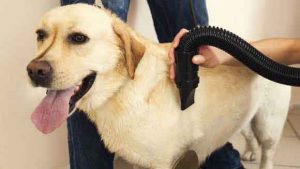Why It’s a BAD Idea to Blowdry Your Pet With a LeafBlower
by William Murphy
Dogs are unlike cats, in that they should be bathed regularly. While cats bathe themselves, dogs require their owners to bathe them to prevent skin problems and to keep them soft and smelling pleasantly.
While it is easy enough to set the dog in a pool or tub and wash him, the next step can be tricky: drying.
There are many misconceptions by people who have not taken the time to properly research how to wash and dry their dogs.
Many people assume that what is good for humans is also good for our animal friends, but oftentimes these same things can cause harm to our animal friends.
Today we explain why it’s a bad idea to blowdry your pet with a leafblower, and give alternatives that will not hurt your pet.
We focus on dogs with this article, because as mentioned, cats do not need to be bathed (unless they got into something stinky). And if you know cats, then you know you’re not getting anywhere close to them with a leafblower.

A hair dryer, maybe; but we cover this later in the article, too.
In the summer months, you may be tempted to let your dog air dry, and this can be okay if your dog has light fur that dries quickly. Most often though, this will leave him smelling like wet dog and there is not a single person on this planet who enjoys that smell.
Sound
It may be cost-effective to get two uses of out of your leafblower, however a leafblower is actually loud enough to give a human tinnitus.
Dogs can perceive frequencies about twice what humans can, and pick up and distinguish sounds four times stronger than humans. A leafblower is not designed to warm and dry water, but rather to pump out air that moves things in front of it.
Designated dog dryers dry fur effectively and safely, leaving coats full and shiny. Their engines are designed to output air in such a way that penetrates undercoats for a thorough drying that pushes water away from the coat.
Additionally, they are significantly (and by that we mean extremely) quieter than a regular leaf blower. They are made with polyethylene housing instead of the aluminum or metal housing, and are designed so the motor is acoustically dampened.

Pollution
Many leaf blowers are gasoline-powered. The inhalation of gas is harmful to humans, and that goes double for our animal friends whose lungs and hearts are smaller than ours.
As well, leaf blowers pick up and distribute a concentrated amount of dust and dirt, which will result in health problems for the pet.
These health concerns include cough or respiratory issues, eye problems, snorting or rubbing of the nose as dirt inflames the mucous membranes, and skin issues like itching and scratching.
Cats and dogs react on a cellular level to leaf blowers, as the sudden noise of a blower starting will startle them and release a large amount of cortisol (stress hormone) into their bloodstreams.
It is sometimes difficult to gauge the health of our animal friends, as they cannot directly communicate with us.
However, leaf blowers cause pollution and noise damage to both humans and pets (if you use a leaf blower to clear your yard, we recommend using appropriate ear and eye safety gear).
Using a Hair Dryer
If you don’t want to purchase a dog dryer, you can use a blow dryer meant for human hair, but there are a few things to keep in mind:
- Keep the nozzle a few inches from the dog’s fur, and keep it in constant motion. If you linger too long, it may cause a burn. They can’t warn us that the air is getting too hot, and will only cry out in pain when it’s too late. It’s easier to do this on our own hair because we can feel the temperature. Be sure to set the heat to the lowest possible setting, too.
- You will have to get your pet used to the sound and feeling of the dryer. You can do this in stages by showing the dryer when it’s off, and rewarding the dog with treats and praise. Then turn it on, keeping it away from him, still rewarding with treats and praise to warm him up to the noise. Finally you can bring the dryer closer, bit by bit, always rewarding with treats and praise, in order to build a pleasant grooming experience between the two of you. Animals (and people) always respond better to positive reinforcement, so be sure to reward your pup, and he will learn not to fear the dryer, but rather look forward to it!
If you are bathing your dog regularly, you will want to invest in a proper dog dryer to keep his coat beautiful, and to ensure a thorough drying of the undercoat as well as the top coat.
Save
Related posts:
- DeWalt DCBL720P1 Leaf Blower Review
- Can You Dry Your Car with a Leaf Blower? (YES YOU CAN)
- Can You Dry Your Motorcycle With a Leaf Blower? Yes you can!
 |
 |
 |
 |

About William Murphy
William has worked as a general contractor in the city of Fremont, CA for over three decades. During that time, he's written articles about architecture, construction, and environmental protection for various publications. He is an expert on green building and sustainable design. When he's not writing or working, William enjoys spending time with his wife and two children.
Thoughts on "Why It’s a BAD Idea to Blowdry Your Pet With a LeafBlower"
 |
 |
 |
 |
You can Get FREE Gifts. Receive Free Backyard Items here. Disable Ad Blocker to get them all now!
Once done, hit anything below
 |
 |
 |
 |